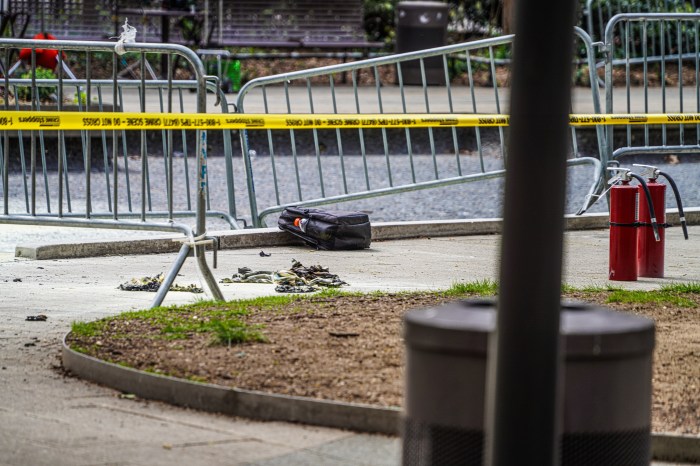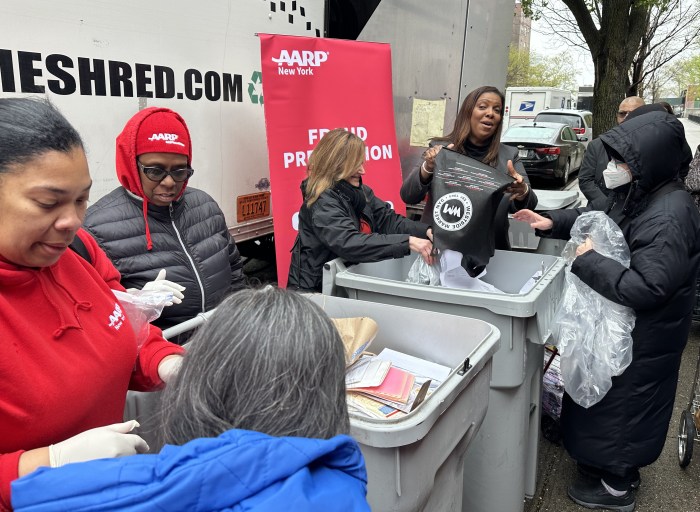BY LINCOLN ANDERSON | More than 400 people turned out for a public forum on Pier 40 last Thursday night, to hear presentations on two competing plans for the crumbling structure — including one that would add a pair of 22-story residential towers at the foot of the pier.
The standing-room-only crowd packed the ground-floor meeting space at the Saatchi & Saatchi building, just two blocks east of the sprawling but dilapidated 15-acre pier near Houston St.
The Pier 40 Champions plan would convert the pier into primarily a sports center, doubling upon its existing, generous athletic field space. To fund sorely needed repairs for the aging pier, the proposal would include two high-rise towers located within Hudson River Park, just east of the pier. However — a critical requirement — a legislative change to the Hudson River Park Act of 1998 would be needed to allow housing in the park.
The plan is also backed by the Downtown Little League and the Downtown Soccer League, which are both looking for more field space beyond Battery Park City.
The rival plan, by the Durst Organization, is an adaptive reuse of the current pier-shed structure, but would also require a change in law because it requires a long-term lease. The pier’s parking operation would be consolidated into less space via parking stackers, while new commercial uses would be added to the pier, including a mix of high-tech offices and retail.
Sporting their blue soccer training jackets as they filed into the meeting, about 20 members of The zum Schneider FC came to support the Pier 40 Champions plan.
“We hold five permits at Pier 40. We’ve been playing there about ten years,” said Joseph Roubeni, the 150-member soccer club’s director.
Asked about the two 22-story towers, Roubeni said, “I think it’s a bit of a tradeoff, but if it could help push the financials at Pier 40, then I’m for it.”
Meanwhile, standing nearby, Maria Passannante-Derr, a former chairperson of Community Board 2, was lobbying people to oppose the Champions plan and asking them to sign a petition.
In the wake of Hurricane Sandy, Derr said, “I think it’s impractical to build on the water right now.”
Tobi Bergman, president of P3 (Pier, Park & Playground Association) — a member of the Pier 40 Champions coalition of youth leagues — said that, as of this Tuesday, they had received more than 5,000 signatures on their own petition in support of their plan.
The leagues also did a good job turning out people for the meeting, judging by the strong applause levels at various times during the evening.
Assemblymember Deborah Glick and State Senators Brad Hoylman and Daniel Squadron have all made it clear that they have serious issues with the idea of housing in the park.
This Tuesday, a spokesperson for City Council Speaker Christine Quinn told Downtown Express that Quinn also opposes housing in Hudson River Park.
“”The Speaker supports a set of principles for the development of the Pier 40 including a commitment to no residential development. Any future development at this site must retain the playing fields and not relegate them to a roof of the structure. Finally, we must do everything we can to work together to expand park space, and add more playing fields at both Pier 40 and throughout the park.”
Madelyn Wils, president of the Hudson River Park Trust — the state-city authority that operates the 5-mile-long riverfront park — outlined the greensward’s dire financial situation. The park is supposed to be financially self-sustaining, but with 70 percent of it complete, the park’s operating budget has grown to $16 million per year.
Every day something new is going wrong with the infrastructure of the 50-year-old building on the pier and needs to be fixed, Wils said.
“Pier 40, historically, supported 35 percent of the park’s revenue,” she noted. “Now the park is funding Pier 40 — it’s costing $2 million [per year] for the Trust to keep up Pier 40.
“We’re looking at well over $125 million to fix the pier — and we just don’t have the money,” she said. So, the Trust is now mulling a “managed shutdown” of Pier 40, she said, and this year will consider shutting down the parking on the pier’s south side, where the roof is in bad shape.
Wils indicated the Trust’s plan is to put out a request for proposals, or R.F.P., for the pier in a few years. But, unlike previous R.F.P.s that failed in 2003 and 2005, she said, this time the park act should be opened first, to allow a wider range of legal uses.
Douglas Durst, chairperson of the Durst Organization, one of the city’s biggest developers, gave the opening remarks about his proposal. Durst was until recently chairperson of Friends of Hudson River Park, the park’s leading fundraising group, but resigned last December over differences with the Trust about Pier 40.
Differing from Wils’s assessment of Pier 40, he said, “The building is in good condition and can be used to support the park. Adaptive reuse of the pier would be the fastest way to stabilize it while minimizing the impact on existing uses,” clearly referring to the popular sports fields.
Durst said Pier 40’s current layout is just what today’s tech firms are looking for: large floor plates and high ceilings.
His plan would avoid “the demolition and disruption of building two, 300-foot towers and razing half of the pier shed,” he added.
On the other hand, the Pier 40 Champions plan calls for opening up the pier by removing the middle segments of its eastern and western walls.
Durst’s project cost would be $384 million.
Partnering with Durst in the concept proposal is Ben Korman, who used to run the parking at Pier 40. Until now, Durst and Korman have said they are just “putting the idea out there” to be helpful. But last Thursday, Korman hinted they might be interested in actually doing the project.
The Champions plan, like Durst’s, also features a running track.
By removing the middle part of the pier shed on Pier 40’s eastern and western sides, Bergman explained, “The idea is to connect the park to the pier and the pier to the river.”
Bergman took a shot at Durst’s concept plan, saying that its retail space would necessarily attract large-sized retailers, and that it would take years to locate a good one.
“You can’t have mom-and-pop shops, Murray’s Cheese, in 400,000 square feet of space or even 100,000 square feet of space,” he maintained. “You need an anchor tenant.”
Due to Lower Manhattan’s population boom, the Champions’ idea calls for adding even more playing-field space to Pier 40 than there is now.
“The same amount of fields is not enough,” Bergman asserted. “We’re going to have conflicts between one community and the next.”
As to the towers’ height, he said it would roughly be the same size as the Saatchi and Saatchi building in which the forum was being held.
The Champions total project cost is slated at $691 million, including $493 million for the two towers and $197 million for pier repairs and renovations.
The Trust recently commissioned real estate consulting firm Newmark Grubb Knight Frank to do financial models for both the Durst and Champions plans. Newmark recommended that the best scenario for the Champions plan would be one 280-unit residential condo building paired with one 326-unit “80/20” rental building, with 80 percent market-rate units and 20 percent affordable units; the developer would get a property-tax break for creating the affordable units.
In Newmark’s analysis, rents for the market-rate units would range from $3,580 for studios, to $4,500 for one-bedrooms, $6,500 for two-bedrooms, and $8,645 for three-bedrooms. Meanwhile, the affordable studios would rent for $647 per month, one-bedrooms $812, two-bedrooms $1,175, and three-bedrooms $1,560.
The Newmark report concluded that Durst’s numbers were overly optimistic.
Each team claimed that their proposal during construction would be less disruptive of the ball fields’ use than the rival plan.
A convert to the idea of housing in the park, Assemblymember Richard Gottfried said he felt the park act should be opened up to allow new types of uses for both Pier 76, at W. 36th St., in his district, as well as Pier 40. Gottfried co-authored the park act along with former state Senator Franz Leichter, who was seated in the front row, next to Bergman.
However, new State Senator Hoylman took a hard line on residential use in the park. He also emphasized that the city and state need to allocate more money “to keep up the park,” especially given that the city recently allocated $260 million for Governors Island and has given $130 million to the High Line. So far, over the years, the city and state have given Hudson River Park $350 million to fund construction costs.
For her part, Glick said, “The pressure for development on the waterfront will never change. The easiest thing to do is say, ‘Let’s take a chance on high-rise development.’ ” “I appreciate the effort of the Champs,” she said. “They were given financial targets by the Trust. But two 22-story buildings right in front of Pier 40 would have your kids playing in shadows in the morning, and in the afternoon — with the pier shed down on the west side — winds coming in.
“The only thing that keeps [the Trust] from making bad decisions are the protections in the legislation,” she stressed.
Also, she asserted, “You don’t need $120 million right at the beginning. You can fix the pier in phases.”

















